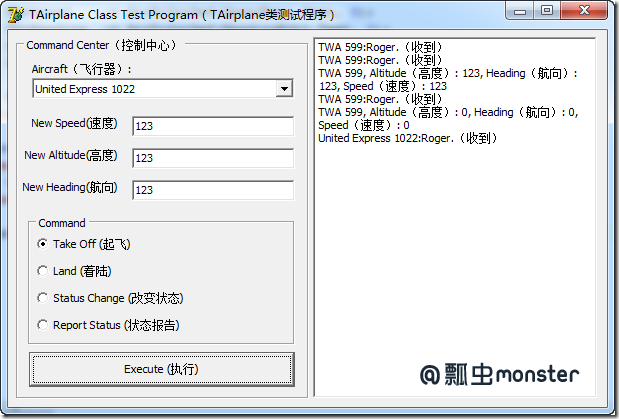类实例
讲解了这么多讲了,在此举例一个类的例子是最好不过的了。下面的单元中,包含了一个名叫TAirplane的类,这个类可用于飞机控制器程序。这个类可通过发送有关信息来操作飞机,它可指示飞机起飞、降落,或者改变航程、高度、速度等。先来看看这个单元吧。
清单 Airplane.pas
unit Airplane;
interface
uses
SysUtils;
const
{ 飞机类型}
Airliner = 0; { 班机}
Commuter = 1; { 通勤机}
PrivateCraft = 2; { 私人机}
{ 状态常量.}
TakingOff = 0; { 起飞}
Cruising = 1; { 巡航}
Landing = 2; { 着陆}
OnRamp = 3; { 停机坪}
{ 消息常量.}
MsgChange = 0; { 改变}
MsgTakeOff = 1; { 起飞}
MsgLand = 2; { 着陆}
MsgReport = 3; { 报告}
type
TAirplane = class
private
Name: string; { 飞机名称}
Speed: Integer; { 飞行速度}
Altitude: Integer; { 飞行高度}
Heading: Integer; { 飞行航向}
Status: Integer; { 飞行状况}
Kind: Integer; { }
Ceiling: Integer; { 飞行升限}
protected
procedure TakeOff(Dir: Integer); virtual; { 起飞}
procedure Land; virtual; { 着陆}
public
constructor Create(AName: string; AKind: Integer = Airliner);
function SendMessage(Msg: Integer; var Response: string; { 发送消息}
Spd: Integer; Dir: Integer; Alt: Integer): Boolean;
function GetStatus(var StatusString: string): Integer; overload; virtual;
function GetStatus: Integer; overload;
function GetSpeed: Integer;
function GetHeading: Integer;
function GetAltitude: Integer;
function GetName: string;
end;
implementation
{ TAirplane }
constructor TAirplane.Create(AName: string; AKind: Integer);
begin
{ 初始化过程,设置飞机名称、类型和升限}
inherited Create;
Name := AName;
Kind := AKind;
Status := OnRamp;
case Kind of
Airliner: Ceiling := 35000;
Commuter: Ceiling := 20000;
PrivateCraft: Ceiling := 8000;
end;
end;
function TAirplane.GetAltitude: Integer;
begin
Result := Altitude;
end;
function TAirplane.GetHeading: Integer;
begin
Result := Heading;
end;
function TAirplane.GetName: string;
begin
Result := Name;
end;
function TAirplane.GetSpeed: Integer;
begin
Result := Speed;
end;
function TAirplane.GetStatus: Integer;
begin
Result := Status;
end;
function TAirplane.GetStatus(var StatusString: string): Integer;
begin
StatusString := Format('%s, Altitude(高度): %d, Heading(航向): %d, ' +
'Speed(速度): %d', [Name, Altitude, Heading, Speed]);
{ 返回 名称,飞行高度,航向,速度 信息}
Result := Status;
end;
procedure TAirplane.Land;
begin
{ 飞机着陆,设置速度为0,航向为0,高度为0,状态为停机坪}
Speed := 0;
Heading := 0;
Altitude := 0;
Status := OnRamp;
end;
function TAirplane.SendMessage(Msg: Integer; var Response: string; Spd,
Dir, Alt: Integer): Boolean;
begin
Result := True;
{ 根据Msg消息的类型,响应不同的命令}
case Msg of
MsgTakeOff: { 起飞命令}
{ 如果已经在飞行,就不能响应起飞命令}
if Status <> OnRamp then
begin
Response := Name + ':I''m already in the air!(已经在飞行中)';
Result := False;
end else
TakeOff(Dir);
MsgChange: { 改变速度、航向、高度的命令}
begin
{ 飞行速度不能大于500,航向不能超过360度,高度不能低于100,}
if Spd > 500 then
Response := 'Command Error(错误指令): ' +
'Speed cannot be more than 500.(速度不能超过500)';
if Dir > 360 then
Response := 'Command Error(错误指令): ' +
'Heading cannot be over 360 degress.(航向不能超过360度)';
if Alt < 100 then
Response := Name + ':I''d crash!(飞行高度太低,将要坠毁!)';
if Alt > Ceiling then
Response := Name + ':I can''t go that high.(飞行高度超过该飞行升限)';
if (Spd = 0) and (Dir = 0) and (Alt = 0) then
Response := Name + ':Huh?(嗯?无法理解的指令)';
if Response <> '' then
begin
Result := False;
Exit;
end;
{ 如果飞机不在停机坪,则响应指令,改变状态}
if Status = OnRamp then
begin
Response := Name + ':I''m on the ground.(我已经在停机坪)';
Result := False;
end else begin
Speed := Spd;
Heading := Dir;
Altitude := Alt;
Status := Cruising;
end;
end;
MsgLand:
{ 着陆指令}
{ 如果已经在停机坪,则不响应该命令}
if Status = OnRamp then
begin
Response := Name + ':I''m already on the ground.(我已经在停机坪)';
Result := False;
end else
Land;
MsgReport: { 返回当前飞行状况}
begin
GetStatus(Response);
Exit;
end;
end;
{ 如果命令得到执行,返回收到}
if Result then
Response := Name + ':Roger.(收到)';
end;
procedure TAirplane.TakeOff(Dir: Integer);
begin
{ 设置航向起飞}
Heading := Dir;
Status := TakingOff;
end;
end.分析
首先看看interface段的类声明,注意TAirplane类有一个重载函数叫GetStatus。当用一个字符串参数调用GetStatus时,在返回一个状态字符串的同时还会将Status字段返回。当不用参数调用时,只是返回Status字段值。其中存取私有字段的唯一方式是通过公用方法。例如只有通过发送有关信息才能改变速度、高度和飞行航向。
现在在关注下implementation段中的TAirplane类定义,构造函数执行一些初始化工作,SendMessage函数做了主要工作,Case语句决定发送哪个信息并采取相应行动。其中TakeOff和Land过程是不能直接调用的(它们在protected下),但可以通过SendMessage函数调用。
其中有些过程声明的后面有virtual关键字,此声明表示该函数为虚拟方法(virtual method)。
在该讲的代码示例中有一个Airport程序,此程序能够充当飞行交通控制器,截图如下:
此程序首先创建三个TAirplane类数组,然后建立三个TAirPlane类实例。通过选择飞机,可向任何飞机发送有关信息,为这些信息设置参数,然后点击“Execute(执行)”按钮,然后就会调用被选中飞机的SendMessage函数,当消息发送时,会得到飞机的返回信息,此信息显示在Memo控件中,运行此程序,感受下此程序是如何工作的。
以上代码均在Delphi7中测试通过,实例代码下载:Airplane飞行类的实现.rar







 本文介绍了一个名为TAirplane的类的设计与实现,该类用于模拟飞机的各种操作,如起飞、降落及改变航向等。文章详细展示了类的定义、成员变量及方法,并通过实例演示了如何使用此类进行飞机状态的管理和控制。
本文介绍了一个名为TAirplane的类的设计与实现,该类用于模拟飞机的各种操作,如起飞、降落及改变航向等。文章详细展示了类的定义、成员变量及方法,并通过实例演示了如何使用此类进行飞机状态的管理和控制。


















 837
837

 被折叠的 条评论
为什么被折叠?
被折叠的 条评论
为什么被折叠?








